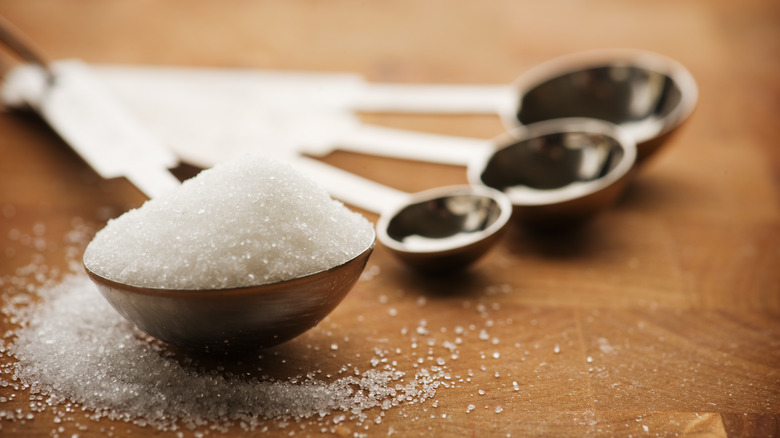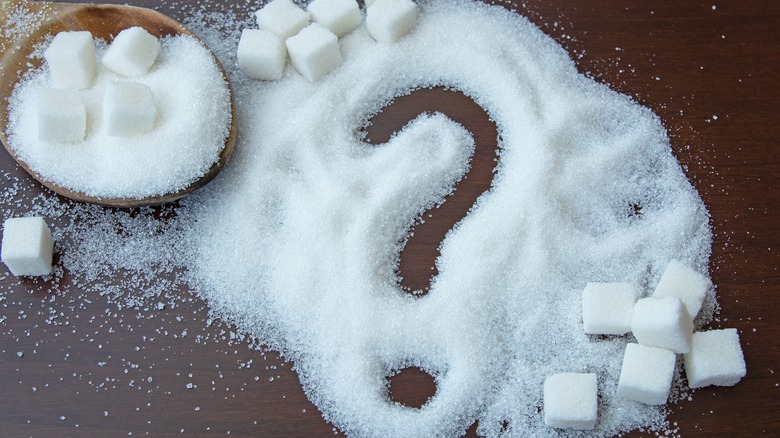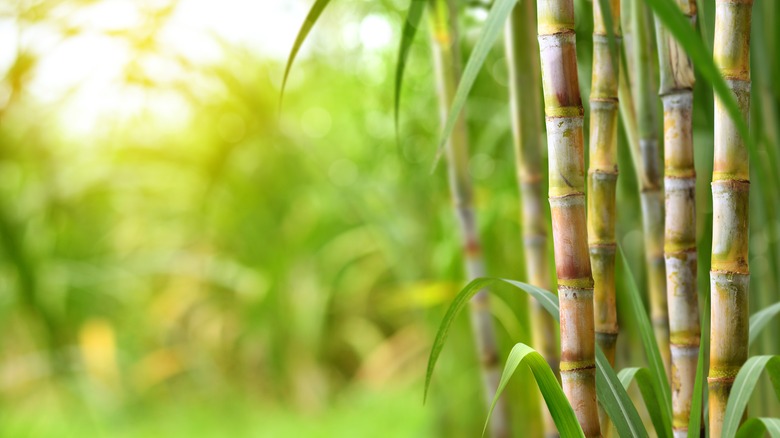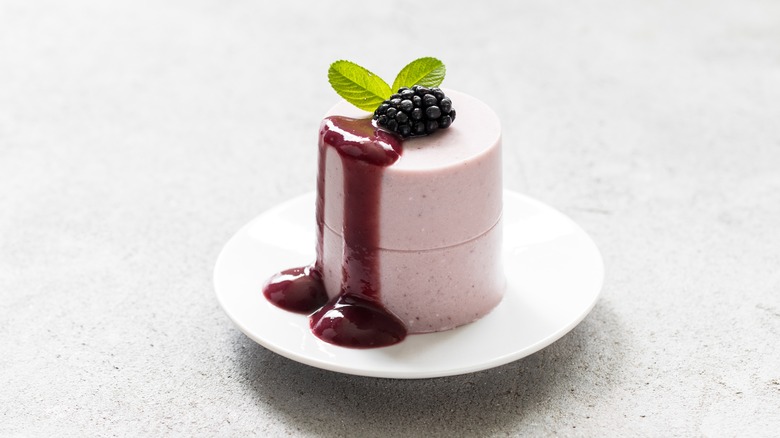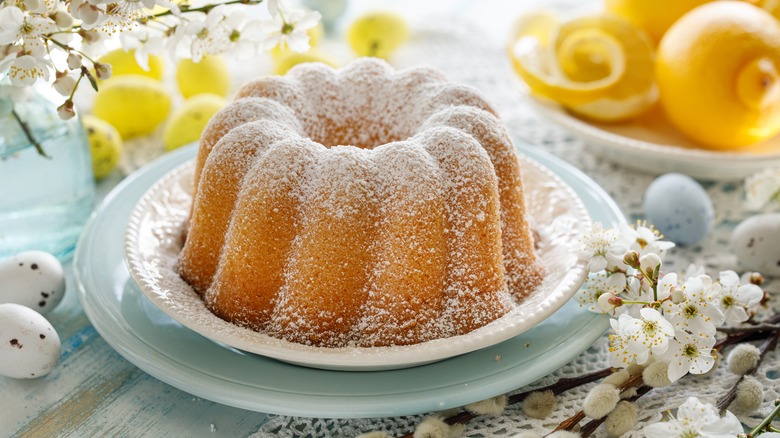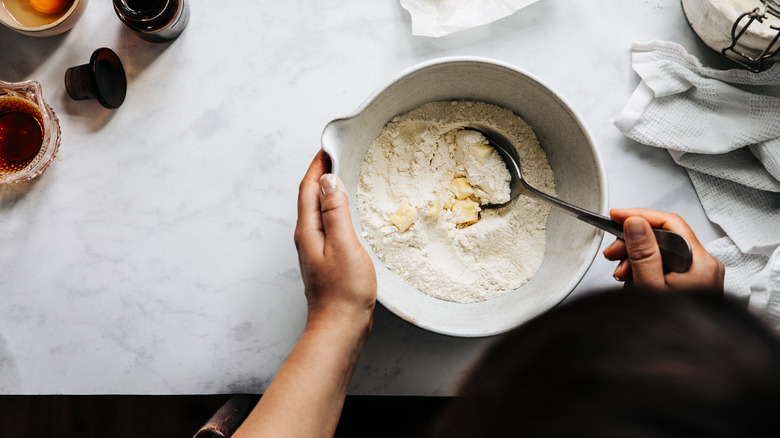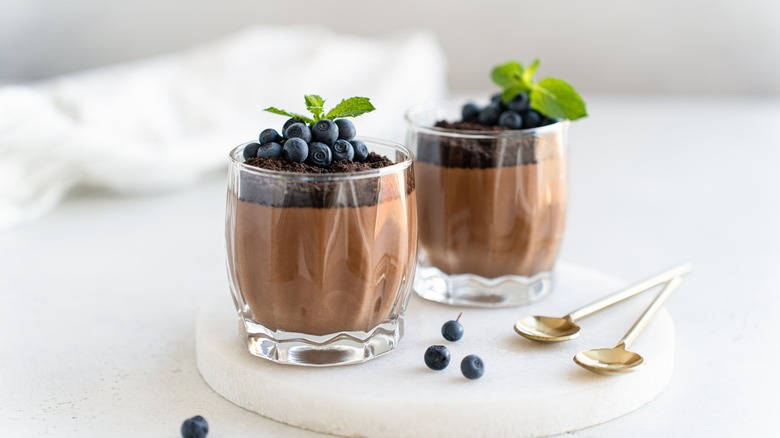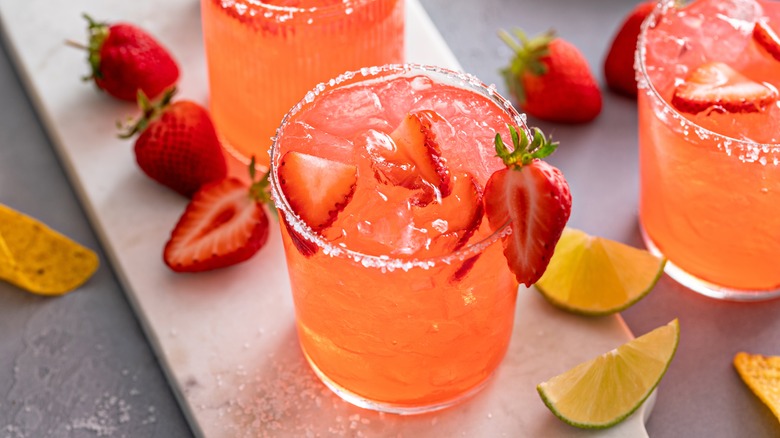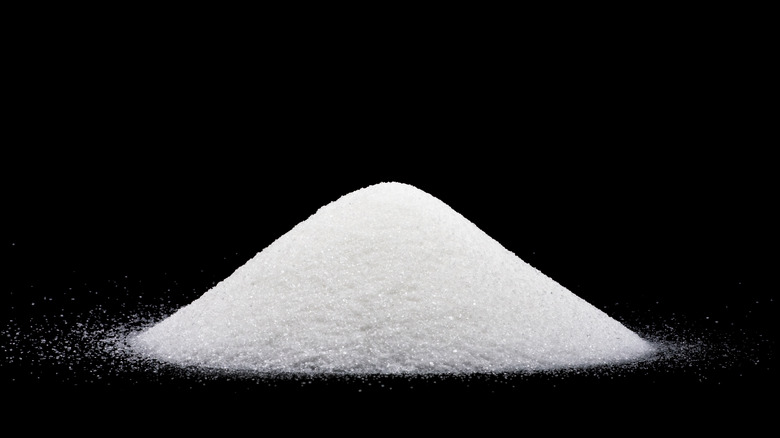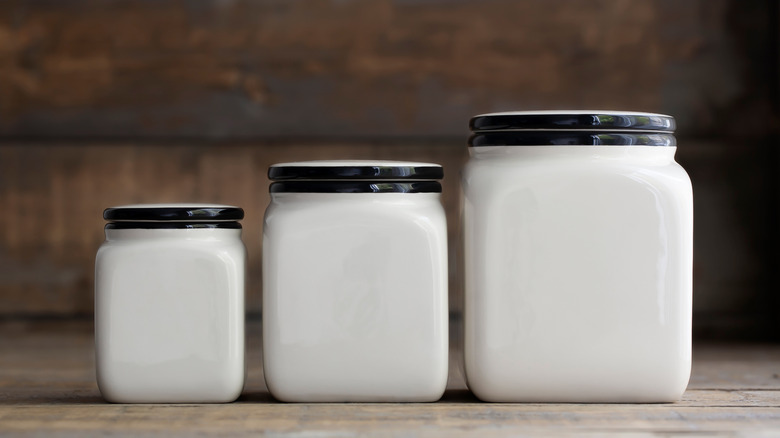The US Name For Caster Sugar And Where To Find It
We may receive a commission on purchases made from links.
Caster sugar, which is called "superfine sugar" in the United States, is most likely not a common ingredient in your baking cabinet. Even if you're no stranger to whipping up a morning batch of yeast donuts or desserts for the end of a meal, chances are good that you haven't heard of either name.
That's because caster or superfine sugar inhabits a strange middle ground between the much more common granulated and powdered varieties, and many American home cooks are only familiar with it because it sometimes crops up on "The Great British Bake Off." However, caster sugar is a useful ingredient to have around the house.
Not only does it work miracles for lighter baked goods such as whips and meringues, but it is also useful for dinner and drinks as well. Perhaps it's time you found out more about it, from its background and provenance to uses, substitutes, purchasing tips, and storage requirements. Get ready to join those "GBBO" stars in caster sugar expertise.
What is caster sugar?
The first question many people ask is: What the heck is caster sugar? In order to understand this, it's useful to take a brief foray into the world of sugar, of which there are many kinds.
First, we have granulated sugar, which is the Plain Jane ingredient almost every servantless American cook (thank you, Julia Child) has in their cupboards. It is also known as white or table sugar. Next is brown sugar, which is made by adding molasses to the cooking process. Powdered sugar is finely ground until it becomes dust, while raw or turbinado sugar is the sugar crystal in its least processed form.
That's already a lot of ingredients to keep track of, and now we're adding another: caster or superfine sugar, the latter name used on packages in the U.S. This is a kind of sugar that is like granulated or table sugar but with smaller crystals. Some people say caster sugar is simply another name for confectioner's sugar, aka powdered or icing sugar, but that is incorrect. Because of this, you can't simply substitute caster sugar for other ingredients. It is its own ingredient, and if a recipe calls for caster sugar, you should do your research before making a substitution.
What is caster sugar made of?
Caster is exactly the same ingredient as granulated sugar chemically and biologically. It comes from the sugar cane plant (Saccharum officinarum), which was likely domesticated toward the start of the agricultural revolution about 10,000 years ago, likely in Southeast Asia and New Guinea. Today, sugar cane grows well in tropical regions, its biggest exporters being Brazil, Thailand, India, and China.
Making sugar is an involved process. First, the canes are harvested from fields and crushed to release their juices. These are collected and filtered to purify the juice before boiling it into syrup, which is further reduced until it granulates into raw sugar (often recognizable at the store for its amber color). From there, it is sent to refineries where it is refined into white sugar, ground to a specific size, and sold. The only difference between granulated and superfine sugar is how small it's milled, which gives it different physical properties.
Superfine sugar is a formulation that retains its gritty feel, like granulated sugar, but is smaller. It's hard to say how small, exactly. Some corners of the internet estimate that granulated sugar is roughly half a millimeter and caster sugar about .35 millimeters; other sources say it's closer to .15 millimeters. Either way, it's smaller, which has some interesting properties discussed below.
What is it used for?
Table sugar will dissolve in liquid when the bonds between individual sugar (sucrose) molecules come apart, leaving the molecules intact (i.e. still chemically the same and tasting sweet). However, this doesn't work too well in cold liquids, which is why you sometimes have problems with getting all the sugar in your lemonade to dissolve, for example. For that reason, some home cooks turn to simple syrup for sweet drinks.
Heat's not always an option, though. The same problem can arise in recipes for icing, frosting, whipped cream, or other desserts that require the incorporation of sugar in a cold state. Therefore, caster sugar is perfect for recipes where you want the ingredients to dissolve quickly and completely. For instance, in meringues, macarons, and whipped cream, you neither want chunks of gritty sugar present nor do you want to use heat to get it to dissolve (as you would with a simple syrup in lemonade). In whipped cream, that risks overdoing the cream and transforming it into butter, while in meringue, waiting for the sugar to dissolve in the water risks burning it.
Sure, you can use powdered sugar for many of these recipes, but sometimes you want pure sugar (powdered has additives). For that reason, you shouldn't make a powdered sugar substitute before you know what you're doing.
So can you substitute powdered sugar?
The short answer is no, you cannot use caster sugar interchangeably with powdered sugar. That's not to say there aren't recipes where one works in place of the other, because sometimes that is the case. However, the two ingredients have different properties.
On the one hand, caster sugar is not as fine as powdered sugar, and will not melt into the other ingredients in the same way (e.g. if you're making buttercream icing). So if the recipe calls for powdered sugar, don't simply throw in caster and hope for the best. Instead, you can use caster sugar to make powdered sugar using a food processor if you need to; just look up "how to make powdered sugar" on the internet and sub in table or caster sugar, whatever you have.
On the other hand, powdered sugar lacks the structure of caster sugar since, as the name suggests, it has been blitzed to a powder. Plus, powdered sugar sometimes contains other additives to prevent caking (like cornstarch). Therefore, you can't simply substitute powdered sugar into a recipe that calls for caster sugar, as it could change the chemical properties of a baked good or throw a spanner in the works when making a candy recipe.
How about substituting granulated sugar?
Caster sugar and granulated sugar are much closer to the same thing, the only difference being their size. Therefore, substituting granulated sugar for caster sugar or vice versa is a better bet than making a swap with the powdered variety.
Since caster sugar is finer, you wouldn't want to substitute it into just any recipe that calls for granulated sugar, though. For instance, cheesecake crust is held together by the sugar, not the flour. Because of that, you don't want to chance sacrificing its structural integrity. Also, because castor sugar is ground more finely, it is heavier per cup. That means unless you are using a recipe that calls for weight, you risk not using enough granulated sugar, which can have repercussions since baking is a fundamentally chemical process.
If you really need to sub in one for the other and only have volume measurements (e.g. cups rather than grams), then do your research to find out how much a cup of the type of sugar you need weighs and do the math on how many cups that will translate to for the other. If it sounds like a lot of work, take heart: once you get used to it, it's really not hard. Plus, this could be the excuse you need to start using a scale for baking.
Caster sugar in desserts
It's no surprise that if you look for dessert recipes that call for caster sugar, you'll call up a bunch of British and Australian hits. The ingredient, due to its smooth properties, features significantly in meringues and bars (called "slices" Down Under). Try googling superfine sugar to appeal to the U.S. crowd, and you'll get a lot of recipes on the lighter side: pavlovas, angel food cakes, and meringues.
Either way, caster sugar is an ideal ingredient for desserts. As discussed, it is small, so it dissolves more easily in contact with liquids (both cold and hot) than granulated sugar does. This can be helpful in recipes such as whipped cream, for instance, when you might not want to use powdered sugar because the cornstarch can introduce some grittiness, but granulated sugar doesn't dissolve all the way. It is also recommended for delicate desserts such as vanilla fudge.
If you're an avid experimenter, try using caster sugar in place of granulated sugar in mousses, puddings, and crème brûlée. It's also handy for making candy, as the faster your sugar melts, the less you'll have to worry about burning the melted liquid while waiting for the rest of the sugar to dissolve.
Caster sugar in cocktails
Because caster sugar dissolves so easily, it's a bartender's best friend. Cocktails are served cold, and many bars don't even have hot toddies on the menu. Therefore, a sugar that dissolves in liquid without needing to be heated is a shoo-in for making mixed drinks. Even if you are making a simple syrup, caster sugar dissolves more quickly and is an easier route to take when putting together lots of drinks at once.
If you want to try creating a sugared rim effect with a finer granulation, you can opt for superfine sugar over granulated. Simply turn the glass upside down and wet it in a shallow plate filled with water or juice, then dip it into another shallow plate filled with sugar. This simple effect repays itself many times over in wow factor and will work for a wide variety of cocktails. (Of course, you can use this technique for salt as well.)
Caster sugar in savory dishes
Believe it or not, you can even use caster sugar in savory dishes. Some cooks think it is the superior choice, given how easily it dissolves without requiring extra mixing or applications of high heat. Thus, it adds sweetness to dishes that need it, without requiring a lot of exerting your will on the recipe. This is especially important in recipes such as Chinese buns, where you want that subtle but not dessert-like sweetness without any granulation or grittiness.
Sugar is also good for masking flavors, and it is especially good for fish. Not only does it help your fish develop a nicely browned crust, but it also helps to cut some of the fishiness that even the nicest fillet can sometimes carry. Best of all, sugar works for fresh or canned fish, and superfine sugar can give you a nice, even coating. You can also mix it into your fish fry dredge.
Where can you find caster sugar?
It's possible that part of the reason the Brits put such a focus on caster sugar as an ingredient is that their granulated sugar is coarser than that you'll find elsewhere, according to Nigella Lawson. For that reason, they might just be more motivated than the rest of us to have a finer option on hand. Either way, it's not easy to find caster sugar labeled as such once you leave the Isles.
Although sugar packaged as caster sugar might prove hard to find in US grocery stores, you can feel just fine buying superfine sugar, which is much more likely to be the name on boxes and bags. Some stores, such as Whole Foods, do carry caster sugar in their product lines, though you may not be able to find it in smaller stores or other grocery stores.
If you're truly dedicated to getting caster sugar, you can always go to an import store, but there's really no difference in the ingredient simply because it carries a different name. (Seriously, your time is better spent learning to make fudge that for once won't crumble even though you did everything right.) You can also buy caster sugar online or make it, as discussed below.
What to look for when buying caster sugar
When looking for caster sugar, there are a few things to look for. Note that it may be spelled as castor sugar if it comes from the U.K. or Australia, but they're the same thing. You may also see it branded as extra-fine or baker's special sugar, both of which denote the same ingredient. It is sometimes listed as ultrafine sugar.
Given its usefulness in the pub, caster sugar may even be sold as bar sugar. Note when buying it that this sometimes comes with a foamer to help create a particular texture in mixed drinks, which you do not want in your baked goods and confections. If you're looking for that nice Great Gatsby-ish effect of foamy cocktails without beating egg whites all day, though, it could be the product for you.
Caster sugar is available in golden varieties, which have a richer flavor (similar to how brown sugar is richer than white). This simply means the sugar has undergone less refining, so more of the original sugarcane substances (the brown ones that turn into molasses when removed) are present. It won't change the chemistry of your recipe, but it may affect the color or give it a slightly deeper taste. If your recipe doesn't specify, this is a personal choice.
Finding caster sugar online
If you can't find caster sugar in a store near you, you can always source it online. Again, you'll find it under any of a raft of names, including caster, castor, superfine, ultrafine, extra-fine, baker's special, or bar sugar. For a fun twist and seemingly to give us all more to talk about at boring cocktail parties and work events, some brands even combine the names. For example, it may be listed as superfine caster sugar, in other unique combos, or simply as one or the other. Neat, and not at all confusing!
There are other options as well. For instance, you can find products made in the United States. Sugarcane is produced in Florida, Louisiana, Texas, and Hawaii, according to the United States Department of Agriculture. If you're all about supporting domestic businesses, look for that. If you're more interested in supporting indigenous communities in the tropics, then look for fairly traded products from other countries.
How to make caster sugar yourself
Because caster sugar is simply smaller granules of granulated sugar, you can make it at home pretty easily with a food processor. It's possible to use a blender or coffee grinder as well. Simply add your granulated sugar to the appliance and pulse it until the substance resembles the size you're looking for, but stop before it becomes powdered.
Recommendations vary regarding how long to blend, with some sources recommending two to three bursts, while others say it will take 1 to 2 minutes. Most likely this is due to the sharpness and power of the food processor, so the best way to tell if you've achieved the right consistency might be to buy an initial box of caster sugar to compare.
Remember that caster sugar is finer than granulated sugar, which means you can fit more of it into a cup without fewer air pockets or space between the granules. As such, to make 1 cup of caster sugar, you'll need slightly more than 1 cup of granulated sugar.
How to store caster sugar
Store caster sugar the same way you would store another sugar. The goal is to prevent it from absorbing moisture, which causes clumping. Although you can blend clumped sugar later to restore its uniformity, there's no guarantee it will have the same nice consistency, so don't risk it.
Put caster (or any type of) sugar in an airtight container or bag, and put it in a cool dark place. Make sure the location is odor-free, since sugar can also take on smells. Avoid the refrigerator, which traps moisture and smells inside, as both outcomes will work against your goal of keeping sugar fresh. If your sugar starts to go off color, clump, or stick to the sides of the container, that's a sign it is too hot or isn't airtight. There is no need to freeze sugar, as it will stay good indefinitely in a closed container in a cool, climate-controlled place.
Caster sugar nutritional information
You might want to sit down for this one, but caster sugar isn't all that great for you. It's the exact same ingredient as sugar and should be treated with equal caution health-wise. Naturally, there's no reason you shouldn't have a treat once in a while (or, if you can't live without chocolate like some of us, every single day). However, it's smart to be aware of its nutritional information.
Sugar contains about 16 calories per teaspoon. When baking, you can translate this to a rough 50 calories per tablespoon or 800 calories per cup of sugar. Although you can pack a bit more caster sugar into a cup than you can of its granulated cousin, the difference is negligible. Keep in mind that "negligible" differences can still throw off the chemistry in your baking, so you should take care when subbing, but for health reasons, it is safe to disregard the difference of a few calories.
Caster sugar contains no meaningful micronutrients (vitamins and minerals) or macronutrients (protein and fat), other than carbs. Cane and beet sugar are essentially interchangeable when it comes to nutrition, and you can use them interchangeably in baking as well. The takeaway? Just make sure you're eating your fruits and veggies, and you can feel free to get cookin' with this unique ingredient.
